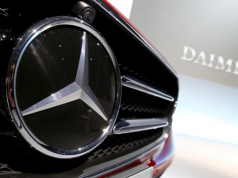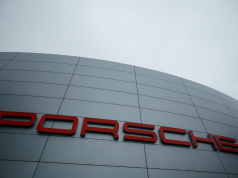
FRANKFURT/DETROIT — BMW and Daimler, the world’s top luxury carmakers, have announced alliances with suppliers, talking up the virtues of having a bigger pool of engineers to develop a self-driving car.
But another motive behind these deals, executives and industry experts told Reuters, is a concern that robocars may not live up to the profit expectations that drove an initial investment rush.
Carmakers are increasingly looking to forego outright ownership of future autonomous driving systems in favor of spreading the investment burden and risk.
The trend represents a clear shift in strategy from little more than a year ago when most automakers were pursuing standalone strategies focused on tackling the engineering challenge of developing a self-driving car, rather than on the business case.
“Although it is a substantial market, it may not be worth the scale of investments currently being sunk into it,” said a board member at one of the German carmakers, who declined to be identified because the matter is confidential.
Dozens of companies – including carmakers and tech firms like Google and Uber – are vying for a market which, according to consulting firm Frost & Sullivan, will only make up about 10 to 15 percent of vehicles in Europe by 2030. There are sure to be losers.
“It’s impossible for me to believe there will be 50 successful autonomous vehicle software producers,” said John Hoffecker, global vice chairman of Michigan-based consulting firm AlixPartners.
In July last year, BMW became the first major carmaker to abandon its solo development of self-driving cars in favor of teaming up with chipmaker Intel and camera and software manufacturer Mobileye to build a platform for autonomous cars technology by 2021.
The decision followed a trip by senior executives to visit startups and suppliers to gauge BMW’s competitive position.
“Sitting at other companies, one rattles off the technological challenges and safety aspects, and you come to realize that many of us are swimming in the same sludge,” Klaus Buettner, BMW’s vice president autonomous driving projects, told Reuters.
“Everybody is investing billions. Our view was that it makes sense to club together to develop some core systems as a platform.”
Daimler’s Mercedes-Benz has since combined efforts with supplier Bosch, three months ago, while Japanese carmaker Honda has said it is open to alliances in the area of autonomous cars.
Even deep-pocketed tech companies are teaming up. San Francisco-based transport app operator Lyft and Alphabet Inc’s self-driving car unit Waymo pooled their resources in May.
Share the burden
Partial autonomy is already a reality in higher-end cars that keep in lane and adjust their speed in motorway driving. Each of the next stages – “eyes off”, “mind off” and ultimately driverless autonomy – will likely take years to become reality.
Klaus Froehlich, BMW’s board member responsible for development, said the company was likely to lose money with its first fully autonomous vehicles, just like it did with its first-generation electric cars. But developing the technology remains a necessity in order to stay relevant as a carmaker.
“It is an enabling technology, not a business case,” he said about BMW’s decision to develop autonomous vehicles. “But if the burden can be shared on a platform, I have nothing against that.”
One of the most financially promising markets that autonomous technology will open up is driverless on-demand taxis, which may one day come to replace regular cabs and parts of public transport in large cities.
“Robotaxis” are expected to drive the wider market for car sharing and ride-hailing, which was worth $53 billion last year and could be worth $2 trillion by 2030, according to a McKinsey study published earlier this year.
Ford and General Motors are investing at least $2 billion each to develop self-driving vehicles for urban ride-sharing fleets beginning in 2021, competing with incumbents and start-ups.
The emergence of alliances involving the likes of BMW and Mercedes-Benz comes at a time when regulators are pushing for a creation of standards for the new technology, which has the potential to improve vehicle reflexes and cut accidents by up to 90 percent, according to Boston Consulting Group.
Industry experts say such standardization could make it much harder to develop a product which stands out, calling into question the wisdom of high-stakes, go-it-alone strategies.
Alliances, merger
In September 2016, the U.S. Department of Transport and the National Highway Transportation Safety Administration released guidance for heavily automated vehicles.
The regulator urged carmakers to disclose how vehicle reflexes are programed, particularly when cars are faced with a dilemma, such as choosing between hitting a cyclist or accelerating beyond legal speeds to avoid an accident.
“It is important to consider whether highly automated vehicles are required to apply particular decision rules in instances of conflicts between safety, mobility, and legality objectives,” the guidance said.
“Algorithms for resolving these conflict situations should be developed transparently using input from federal and state regulators, drivers and passengers.”
European regulators too are debating whether to standardize speeds and distances which autonomous cars need to adhere to while weaving in and out of traffic or joining lanes.
Pressure not to waste development costs is laying the groundwork for alliances and even mergers between the various companies supplying technology for autonomous cars, including makers of vehicles, software, computer chips, radar, camera and laser sensors and high-definition maps.
BMW, Mercedes and Audi put aside their rivalry and teamed up to buy mapping firm HERE, for example, in order to cut their dependence on Google.
What starts out as arms-length agreements designed to capture market share, much like code-sharing deals between airlines, may evolve further into takeovers once the next investment round is due, executives and advisers said.
“Will we see what is happening in aviation be adopted in automotive – where first we see alliances, collaborations and consortiums, and then we see full out market combinations?” asked Bill Curtin, head of mergers and acquisitions at global law firm Hogan Lovells.









